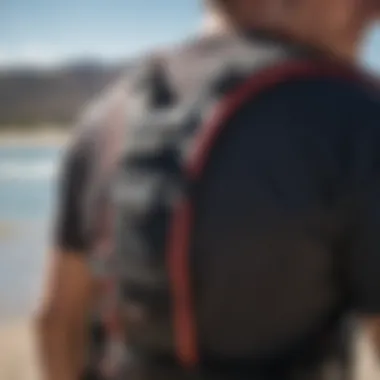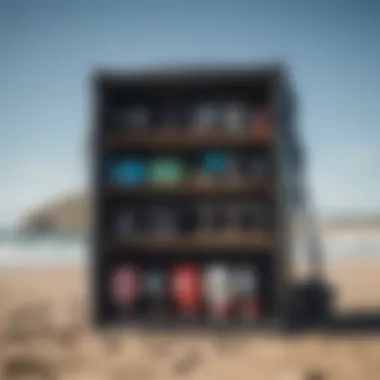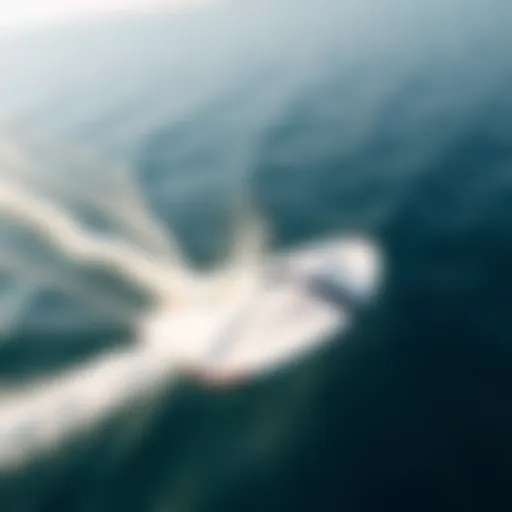Essential Kite Accessories for Every Kiter


Intro
Kite enthusiasts know that the right accessories can make all the difference between a mediocre outing and an exhilarating experience soaring through the skies. When you’re up against the wind, the ocean, and the sheer weight of your kite, having the right gear is paramount. This guide aims to shed light on the essential kite accessories that every kiter should consider.
From reliable lines that withstand the pull of the wind to practical storage solutions that keep your gear in top condition, every element plays a crucial role in enhancing safety and performance.
Let’s delve into some of the must-have kite accessories and tools that can elevate your experience, whether you're just starting out or have been riding the wind for years.
Gear Essentials
Understanding the core components of your kite kit is the foundation of any successful kiting experience. Here, we explore what’s necessary to equip yourself for adventure.
Top Picks for Kite Accessories
- Kite Lines: These are the veins through which the power of your kite flows. Choosing quality lines is essential. Look for those made from Dyneema or Spectra, as they boast strength and minimal stretch.
- Bar and Control System: A well-designed control bar will help you steer your kite precisely. Go for bars that have sufficient grip and easy-to-use safety features. The right width significantly affects your control.
- Harness: The connection between you and your kite often goes overlooked. Invest in a comfy harness that fits right. Remember, it should distribute pressure evenly to keep you comfortable during long sessions.
- Safety Leash: This is non-negotiable. A safety leash is a lifeline in case you need to release your kite quickly. Ensure it’s durable and has a quick-release mechanism.
- Pumps: A good pump makes inflation a breeze. Look for pumps with double-action capability to get your kite filled in no time.
- Storage Bags: Protect your kite gear from wear and tear. Urban and coastal storage bags with waterproof materials can save your equipment from the elements.
Maintenance and Care Tips for Gear
Taking care of your kite accessories is just as important as the gear itself. Here are a few handy maintenance tips:
- Inspect Regularly: Always check for frays or damage before each outing. A small tear can lead to a larger issue at the worst possible moment.
- Rinse After Use: Saltwater and sand can cause corrosion. Give your gear a good rinse down with fresh water after each session.
- Store Properly: Ensure your gear is dry before packing it away. Use a dedicated bag for each piece of equipment to avoid unnecessary scuffs or scratches.
"Routine maintenance can extend the life of your kite accessories. It’s a small effort for big returns."
- Weather Considerations: Avoid leaving your gear out in extreme heat or cold, as fluctuations can degrade materials.
Techniques and Tips
The more adapted your technique is, the more enjoyable your kiting experience will be. This section highlights some pivotal strategies.
Beginner Tips for Kite Riding
- Start with Basics: Familiarize yourself with your kite’s controls. Understanding how to manage the power and direction can make a world of difference.
- Practice Safety Protocols: Always carry a communication device and know how to signal for help if needed.
Advanced Techniques for Skill Enhancement
- Master Body Dragging: Learning how to body drag will enhance your confidence and skills on the water. It’s essential for retrieving your board in challenging conditions.
- Kite Loops: Once comfortable, try incorporating kite loops into your practice. They demand a higher skill level but can significantly improve your control and kite handling.
Choosing the right kite accessories, coupled with skilled techniques, can elevate your time spent kiting. Make informed decisions, and remember, each gear piece is an investment in your enjoyment and safety on the water.
As we move forward in this comprehensive guide, we’ll dissect each accessory's unique traits while also sharing various tips to help you maintain and maximize your kiting experience.
Foreword to Kite Accessories
Kite accessories are the unsung heroes of the kiteboarding experience. They determine not only how well a kite performs in the air but also how safely and comfortably a rider can navigate the waves or the wind. Understanding the significance of these accessories is crucial for anyone who takes their kite sailing seriously. They aren’t just supplementary items; they are essential gameplay components that can make or break a session.
Understanding the Role of Accessories
Accessories in kiteboarding play numerous roles. Each component, from lines to handles, exists to enhance a rider's performance and safety. For example, having the right kind of kite line can drastically affect how responsive your kite is. Thinner lines may allow for quicker maneuvers, but they can also be less durable. On the flip side, thicker lines can provide strength but may hinder speed.
Moreover, accessories like the bridle system soften the impact of gusty winds, ensuring stability without sacrificing performance. The linkage between the kite and the rider is nuanced; the precise gear makes all the difference in achieving fluid dynamics on the water.
If we dive deeper, accessories can also influence the ease of use. For instance, some kite handles come with features that allow for adjustable grip positions. This means riders can tweak their setup on the fly, adapting to changing wind conditions for better control. Simply put, accessories are not merely add-ons; they are critical players in anyone's kiteboarding toolkit.
Importance of Quality Gear
Investing in high-quality kite accessories is non-negotiable. While budget-friendly options might seem like a good idea at first glance, they often lack the durability and performance that seasoned kiters demand. Quality gear goes beyond mere aesthetics—it provides peace of mind. A high-quality harness, for instance, will not only fit snugly but also distribute pressure evenly across your body. This is important to prevent strain and improve comfort during long hours out on the water.


Additionally, consider the materials used in these accessories. For example, a kite line made from high-tenacity polyester may cost more but will resist abrasion better than a cheaper counterpart. This means fewer replacements and better performance. You are essentially setting yourself up for repeated success rather than repeated failure.
"Quality in kite accessories is akin to a sturdy anchor; it may not be seen, but its absence may spell disaster."
Whether you’re an instructor teaching the next generation of kite enthusiasts or a gear reviewer assessing the latest trends, the emphasis on quality ensures that both safety and performance are prioritized. Ultimately, the right set of accessories can elevate not just your game, but your entire kiting experience.
Essential Kite Accessories
Kite accessories play a crucial role in delivering not just a smooth experience, but also enhancing safety and performance. Understanding these essential accessories is fundamental for anyone serious about kiting. From novice kiters still finding their feet to seasoned pros perfecting their craft, knowing what gear to utilize can mean the difference between a fun day out and a risky misadventure.
Kite Lines: Types and Specifications
When it comes to kite lines, it’s more than just picking any rope you see. The type of line can heavily impact your flying experience. Typically, kite lines are categorized into two major types: braided lines and twisted lines. Braided lines are favored for their durability and reduced stretch, giving than much better control and responsiveness in varying conditions. In contrast, twisted lines are simpler and less expensive but may not perform well under pressure.
The thickness and length of your lines also matter significantly. A thicker gauge can withstand tension better, making them ideal for power kiting. However, they can be harder to handle during the launch process. On the other hand, skinnier lines are easier to manage but can snap under excessive force, leading to potentially dangerous situations. Generally, for advanced kite parts, a line length of about 20 to 30 meters strikes a good balance between distance and control.
Kite Handles and Bar Systems
Next in line are kite handles and bar systems. These are the lifelines that connect you to the kite, literally. A good handle or bar offers you both control and comfort—this is not a place to skimp!
Different setups exist, like traditional handles, bar systems with safety release mechanisms, and even adjustable bars. Each has its own advantages. For example, handles tend to be lighter and more portable. They might be suitable for beginners or casual users. However, those who kite regularly might prefer bar systems for their advantages in control and safety.
A significant factor to consider in this realm is ergonomics. An unsuited grip or awkward setup can lead to fatigue and hinder your performance. Investigating options and trying various handles or bars to see what feels natural is worth the effort.
Straps and Harnesses: Finding the Right Fit
Finding the right straps and harnesses is essential for comfort and control. The straps should fit snugly, allowing for full mobility without compromising support. Typically, there are two primary types: waist harnesses and seat harnesses. Waist harnesses sit around the waist and are generally favored by experienced riders for the freedom of movement they offer. However, seat harnesses can provide more support for those just starting out.
In terms of fitting, a good harness feels like a second skin. You should be able to move freely while still feeling secure. Always make sure to try on different types and sizes before purchasing. It’s a small step that can make a world of difference when you’re hundreds of feet up in the air, dancing with the wind.
Bridle Systems and Their Importance
Bridle systems often fly under the radar when discussing essentials, but they can be pivotal for performance. The bridle connects the kite to the lines, acting as a guiding tether. Differences in design can critically influence how your kite flies in various winds.
A well-designed bridle system can optimize the angle of attack, enabling your kite to lift off faster and remain stable in strong winds. In contrast, a poorly built bridle can lead to erratic flight patterns, making controlling the kite challenging and less enjoyable. Pay attention to whether your bridle is adjustable; this feature can mean you can fine-tune your kite’s responsiveness to wind changes, making it essential in varying conditions.
In summary, understanding these essential kite accessories will facilitate an enhanced kiting experience. Each element’s unique properties contribute to performance and safety, ensuring you remain tethered to the sky in the most reliable way possible.
Performance Enhancements
When it comes to kiteboarding, having the right gear is just the tip of the iceberg. The real magic happens when you optimize that gear for performance with thoughtful adjustments and enhancements. This section delves into the various ways you can elevate your kiting experience through strategic tweaks and accessory choices. Performance enhancements are not just for the pros; they’re vital for anyone who wishes to harness the wind effectively, minimize fatigue, and maximize fun out on the water.
Adjustable Kite Settings
Fine-tuning your kite’s settings can completely transform how it flies. Think of it like adjusting the seat in your car; a few inches can make all the difference in comfort and control. Many modern kites come with adjustable settings that allow you to modify aspects like bride length or wing flex. These adjustments enable you to react to shifting wind conditions.
- Bridle Adjustment: Altering the bridle can change the shape of the kite, influencing both lift and depower. Shortening the bridle can result in a faster, more agile response. Conversely, a longer bridle can provide more stability at the expense of speed.
- Changing Wing Shape: Some kites allow you to modify the wing’s profile. By altering its curvature or surface area, you can increase lift or add stability in rough conditions.
Experimenting with these settings isn't merely for better performance; it also allows you to tailor the kite to your personal preferences, ensuring a more enjoyable experience on the water.
The Impact of Weight Distribution
Weight distribution might sound like a dry topic, but don’t let its plain veneer fool you. Misplaced weight on your board or body can lead to erratic flying patterns or unwanted crashes. Every little tweak can have substantial downstream effects.
Understanding how to manage your weight can dramatically increase your kite’s efficiency:
- Positioning on the Board: Moving your body weight forward or backward can change your lift-off behavior. Leaning forward could help you catch more wind, enhancing your speed and jump height.
- Gear Selection: Choosing the right harness and ensuring it fits well impacts how stress distributes across your body when maneuvering. A harness that sits too low can pull you back, unbalancing your stance.


Ultimately, weight distribution is about harmonizing your gear and body to achieve that sweet spot where control and performance blend seamlessly.
Wind Stabilizers and Their Role
Wind stabilizers are often the unsung heroes in the realm of kite accessories. Think of them as safety nets or the training wheels of kiting; they allow you to focus on performance without the worry of sudden gusts throwing you off balance. These accessories come in various forms, such as:
- Stabilizing Fins: These attach to your board and help maintain direction. They give you the necessary grip even if the wind changes swiftly.
- Flags and Streamers: Attaching streamers to your kite can help visualize wind speed and direction. This allows for instantaneous reactions, making adjustments more intuitive.
"Utilizing wind stabilizers isn’t about taking the easy way out; it’s about empowering yourself to navigate the wind like a pro."
In summary, ignoring performance enhancements is like sailing a ship without adjusting the sails. Each of these elements, from making kite adjustments to managing weight effectively, contributes significantly to improving your kiting game. The right combination of gear and smart choices can elevate your experience, protect you from mishaps, and ultimately help you ride the wind with confidence.
Safety Accessories
When it comes to kite surfing or flying, the thrill of soaring through the air is undeniable. However, amid this joy, safety should never take a backseat. Safety accessories serve a crucial role in protecting both the kite enthusiast and their equipment. By understanding the importance of these accessories, one can enjoy their kite-related activities with peace of mind.
Quick Release Mechanisms
A quick release mechanism is like an unsung hero in the realm of kite accessories. It allows a kiter to disengage from their equipment effectively if a hazard arises. Picture this: you're riding the waves, feeling the wind whip around you, and suddenly, conditions shift unexpectedly. In such cases, being able to release your lines quickly can prevent serious injuries.
These mechanisms come in various designs, but the essence remains the same—safety at your fingertips. When shopping for a kite, look for models equipped with reliable and intuitive quick release systems. A well-designed mechanism enables a user to activate it with minimal effort, ensuring that help is just a flick away. Moreover, regular inspection of this part is mandatory; a faulty quick release could be more harmful than having none at all.
Impact Vests and Safety Gear
Traditionally associated with extreme sports, impact vests have carved a niche in the kite surfing community. They come in handy not just as a protection against fall impacts but also as a buoyancy aid. When the wind picks up uncontrollably, and one finds themselves tumbling into the water, having that extra padding can make a considerable difference.
The critical aspect of choosing an impact vest is fit. A snug but comfortable vest allows for movement without feeling like you're wrapped in a straightjacket. Opt for vests that offer ample mobility in the arms; otherwise, your performance may take a hit.
On top of impact vests, other safety gear like helmets should be considered essential, especially when racing or performing tricks. While it might seem excessive to some, protectiveness after all is a small price to pay for an incredible day on the water.
Safety Leashes: Types and Usage
Safety leashes are yet another indispensable accessory. They provide that extra layer of security, keeping your kite attached to you even in rough conditions. There are basically two types: those for the kite, and those for the rider.
- Kite Leashes: Designed to keep the kite from drifting away uncontrollably if it detaches from the lines. These leashes often feature a quick-adjust mechanism for easy attachment and detachment.
- Rider Leashes: Used primarily for board sports, these prevent your board from getting away from you. If you wipe out, the last thing you want is to chase down your gear floating away.
Using a safety leash involves creatively wrapping it around your wrist and ensuring it’s snug yet comfortable. Be sure to check for wear and tear often. With wear, the risk of malfunction rises significantly, creating a potential safety hazard.
"Safety is not just an accessory; it's an investment in your experience."
Maintenance of Kite Accessories
Kite accessories are the lifeblood of any kite enthusiast's arsenal. Regular maintenance is key to ensuring that every piece of gear works efficiently, extending its lifespan and enhancing your overall kiting experience. Whether you're a seasoned kiter or just dipping your toes into this exhilarating sport, keeping your equipment in top shape can make a notable difference.
Proper maintenance not only safeguards your investment but also greatly contributes to safety and performance on the water or in the air. Here's why it matters:
- Safety Concerns: Faulty gear can lead to mishaps. An inspection can catch the small issues before they escalate.
- Performance Optimization: Clean lines, well-kept handles, and functional safety gear will elevate your kiting performance.
- Cost-Effective: Investing time in maintenance often saves you from spending money on replacements.
- Longer Equipment Lifespan: Regular care helps in prolonging the life of your gear, ensuring you can enjoy it for years to come.
Regular Inspection Protocols
Checking your kite accessories isn't just a good practice; it's a necessary one. Here is a simplified checklist to follow:
- Kite Lines: Inspect for any frays, kinks, or signs of wear. Even the smallest damage can lead to catastrophic failure when under tension.
- Straps and Harnesses: Look for worn-out padding and check the buckles for function. If they seem loose or damaged, it’s time to replace them.
- Handles and Bar Systems: Ensure all parts are secured and functioning as expected. Pay special attention to the grips—if they’re slippery, consider replacing them.
- Bridle Systems: A thorough check here can prevent issues during flight. Ensure that connections are secure and that line lengths are equal.
- Safety Accessories: Don’t forget to monitor the quick release mechanisms and safety leashes. They should operate smoothly without any hitches.
It's worth it to get into the habit of inspecting these components before each outing. As the saying goes,
Travel Considerations for Kite Accessories


When it comes to kiting, a well-planned trip can make the difference between an exhilarating experience and a total fiasco. Traveling with kite gear isn't just about tossing it into your trunk and rolling out. It requires strategizing to protect your investments and enhance your overall experience. The nature of kite accessories means you have to consider how to pack, transport, and store them to ensure they remain in tip-top shape.
Packing Techniques for Transport
First things first, packing your kite accessories demands a bit of forethought. The way you stow away your gear not only impacts the condition but also the ease of access when you arrive at your destination. Here are some practical tips to make sure everything is just ducky:
- Organize by Type: Sort your accessories into categories. Kite lines can snag easily, so keep them separated from straps and other gear. Use small bags or pouches to avoid a tangled mess.
- Use Protective Cases: Soft cases for kites and stiff tubes for control bars can save you headaches later. The last thing you want is a broken spar or a tangled line leading to a frustrating launch.
- Layer for Weight Distribution: If you are flying with other gear, like boards or other water toys, ensure the weight is balanced. A top-heavy bag can topple over at the slightest nudge.
- Keep Essentials Accessible: Consider keeping key items like your quick-release mechanisms and safety leashes within easy reach. You never know when you might need them.
Packing well can save you from damage and, more importantly, keep your excitement alive when you finally hit the wind. By organizing, using protection, balancing weight, and keeping essentials near, you're setting yourself up for a smoother sailing—or rather, a smoother kitesurfing.
Choosing Durable Storage Solutions
The right storage solutions can make or break your kiting experience, especially when you’re out on the road. When selecting your storage options, durability should be top of mind. Not all bags are created equal, after all! Here’s what to look for:
- Material Quality: Opt for heavy-duty fabrics that stand up to wear-and-tear. Brands like Dakine and Mystic offer storage solutions designed specifically for kiting, featuring reinforced stitching.
- Water Resistance: Wet gear can lead to mold and mildew—nobody wants that headache. Look for waterproof materials or bags with sealed zippers to keep the elements at bay.
- Portability: Choose bags that have comfortable handles or shoulder straps. You don’t want to lug around something cumbersome while you’re trying to enjoy your time at the beach. A good wheelie bag can make transport a breeze.
- Modularity: Some kits come with removable compartments. That makes it easier to grab just what you need without having to empty everything out.
Combining these elements will not only make transporting your kite gear smoother but also give you peace of mind over time. In the end, durable storage solutions translate to prolonged gear life and happy kiting days ahead.
"Traveling with kite gear is an adventure of its own; prep smart, play hard, and enjoy the ride."
Technological Innovations in Kite Accessories
In the realm of kiting, technological innovations stand as pivotal enhancements that can significantly boost performance and safety. The integration of advanced technologies into kite accessories plays an essential role in making the sport more enjoyable and efficient for enthusiasts of all levels. As we delve into this section, let’s explore how innovations such as smart sensors and advanced materials are reshaping kiting gear.
Smart Sensors and Performance Tracking
Smart sensors embedded within kite accessories have revolutionized how kiters track their performance. These devices offer real-time data on various metrics, including altitude, speed, and wind direction. For instance, imagine a kiter effortlessly gliding over the waves, while an unobtrusive sensor mounted on the kite records every twist and turn. This data can then be accessed via a smartphone app, enabling users to evaluate their sessions post-flight.
"The key to improvement is data; knowing where you excel and where there’s room to grow can literally take your kiting skills to the next level."
Using smart sensors is not just about recording data; it can also enhance safety. For example, some sensors can send alerts if the kite is in a potentially hazardous position, allowing for corrective action before it becomes dangerous. This technology opens new avenues for trainers and learners, letting instructors provide very specific feedback based on actual performance data.
Moreover, performance tracking can lead to a deeper understanding of wind patterns and kite responsiveness. By analyzing this feedback over time, one can adjust their technique, which helps in honing skills efficiently. It makes the sport more approachable, especially for newbies who might otherwise feel overwhelmed by the complexities of kiting.
Materials Advancements for Durability
Underpinning many technological innovations in kiting is the evolution of materials. Advanced materials are not just a trend; they have become a game-changer when it comes to durability. Kite accessories made from newer materials like Dyneema or advanced polymer composites resist wear better than traditional fabrics.
For example, kite lines crafted from Dyneema boast incredible strength-to-weight ratios. This means that a lighter line does not compromise on durability or performance, resulting in less drag and a better overall experience. Many advanced kite manufacturers have adopted these materials into their product lines, indicating their significance in improving kiting gear longevity.
Additionally, recent developments in UV-resistant coatings prolong the lifespan of acccesories, combating the degrading effects of sun exposure. Kite surfers often spend long hours under the sun, which can be harsh on gear. Upgraded materials not only resist damage from UV rays but also maintain their color and structural integrity longer than their predecessors.
Epilogue
When you boil it down, understanding kite accessories isn't just about having the right tools; it’s about enhancing your kiting experience through informed choices. From the lines that keep your kite aloft to the safety gear that shields you from potential mishaps, accessories serve as the silent partners in your flying adventure. The importance of these elements cannot be overstated, as each component often plays a role that significantly affects not only performance but also safety.
Summing Up the Key Accessories
To tie the knot, let’s recap the essential accessories that every kite enthusiast should consider:
- Kite Lines: These are your lifelines. The type and thickness can determine how well your kite responds to the wind.
- Handles and Bars: A good grip allows you to control your kite with precision, which makes it easier to manage in various weather conditions.
- Harnesses and Straps: These should fit like a glove. The right design and comfort can make a world of difference, especially during lengthy sessions.
- Bridle Systems: Often overlooked, but they play a fundamental role in how a kite flies. Understanding these can unlock better performance.
Each category has its own specifications that can cater to individual preferences and requirements. The choice might be overwhelming at first, but diving into the specs often reveals what works best for you individually. Eeach kiter, whether a novice or a seasoned professional, must find the right combo that suits their style and conditions.
Continued Learning and Community Resources
The kite community is rich with knowledge and experience that can help you grow as a kiter.
- Forums and Online Groups: Platforms like reddit.com have dedicated kiteboarding forums where you can pick up tips, find troubleshooting help, or simply share your latest exploits.
- Social Media: Facebook groups focused on kiteboarding often share insights on new gear, techniques, and local spots worth checking out. Learning from other enthusiasts can provide you with new perspectives and ideas.
- Local Classes and Workshops: Many shops or local beaches offer classes or clinics where you can learn directly from experienced instructors. This is invaluable for newcomers.
In essence, combining your experiences with resources from the community can lead to continuous growth. By staying informed and connected, you can navigate the world of kite accessories more effectively, ensuring that every session is safe and enjoyable. Ultimately, it’s not just about the gear — it’s about the knowledge and relationships you build along the way.
"The kite’s journey is as much about the community as it is about the wind."
Embrace the spirit of kiting, and remember: informed choices are what lead to unforgettable experiences.



